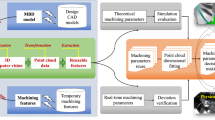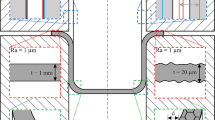Abstract
During the development of CNC machining, the computer-based NC machining simulation has played an important role in verifying the NC programs economically and safely so as to avoid scraps or even accidents. In order to balance the accuracy, efficiency, and fidelity, various simulation methods have been proposed in historical researches, including wireframe, solid, object space-based, and image space-based simulation. All the mentioned methods use G-code as input and take the workpiece blank as a whole part, which causes the difficulty for achieving real-time simulation with acceptable accuracy under limited computing resources. This paper proposed a STEP-NC feature-oriented machining simulation method, which takes the workpiece blank as the combination of several machining features plus the workpiece, and implements customized algorithms for individual features. Using the divide and conquer strategy, high efficiency with guaranteed accuracy and fidelity can be obtained during the real-time simulation. Two demo workpieces with 2.5D features from the STEP-NC standard were tested using the proposed method, and the efficiency was validated by comparing results with the conventional methods.













Similar content being viewed by others
References
Cnc software inc. mastercam (2019). https://www.mastercam.com
Aras E, Yip-Hoi D (2012) State-of-the-art in geometric modeling for virtual machining. In: ASME 2012 international design engineering technical conferences and computers and information in engineering conference, pp 737–750
CAMotics (2018) https://camotics.org/manual.html
CGTech: Vericut (2018) http://www.cgtech.com/
EMC2 (2010) http://www.linuxcnc.org
Gul E, Joseph VR, Yan H, Melkote SN (2018) Uncertainty quantification of machining simulations using an in situ emulator. J Qual Technol 50(3, SI):253–261. https://doi.org/10.1080/00224065.2018.1474689
Huang Y, Oliver JH (1995) Integrated simulation, error assessment, and tool path correction for five-axis NC milling. J Manuf Syst 14(5):331–344
Joy J, Feng HY (2017) Efficient milling part geometry computation via three-step update of frame-sliced voxel representation workpiece model. Int J Adv Manuf Technol 92(3):1–14
Joy J, Feng HY (2017) Frame-sliced voxel representation: an accurate and memory-efficient modeling method for workpiece geometry in machining simulation. Comput Aided Des 88:1–13
Kadir AA, Xu X (2011) Towards high-fidelity machining simulation. J Manuf Syst 30(3):175–186
Karunakaran KP, Shringi R (2007) Octree-to-BRep conversion for volumetric NC simulation. Int J Adv Manuf Technol 32(1–2):116–131
Kobbelt LP, Botsch M, Schwanecke U, Seidel HP (2001) Feature sensitive surface extraction from volume data
Lee SW, Nestler A (2012) Virtual workpiece: workpiece representation for material removal process. Int J Adv Manuf Technol 58(5–8):443–463
Li JG, Ding J, Gao D, Yao YX (2010) Quadtree-array-based workpiece geometric representation on three-axis milling process simulation. Int J Adv Manuf Technol 50(5–8):677–687
Li JG, Yao YX, Xia PJ, Liu CQ, Wu CG (2008) Extended octree for cutting force prediction. Int J Adv Manuf Technol 39(9-10):866–873
Liu SQ, Ong SK, Chen YP, Nee AYC (2006) Real-time, dynamic level-of-detail management for three-axis NC milling simulation. Comput Aided Des 38(4):378–391
Lukic D, Zivanovic S, Vukman J, Milosevic M, Borojevic S, Antic A (2018) The possibilities for application of step-nc in actual production conditions. J Mech Sci Technol 32(7):3317–3328
Miao Y, Song X, Jin T, Shan Y (2016) Improving the efficiency of solid-based NC simulation by using spatial decomposition methods. Int J Adv Manuf Technol 87(1–4):421–435
Nishida I, Okumura R, Sato R, Shirase K (2018) Cutting force simulation in minute time resolution for ball end milling under various tool posture. J Manuf Sci Eng, 140(2 SI)
O’onnell J, Jablokow (1993) Construction of solid models from nc machining programs. ASME Production Engineering Division (Publication) 64:157
Rivièrelorphèvre E, Huynh HN, Verlinden O (2018) Influence of the time step selection on dynamic simulation of milling operation. Int J Adv Manuf Technol 95(7):1–16
Roy U, Xu Y (1998) 3-D object decomposition with extended octree model and its application in geometric simulation of NC machining. Robot Comput Integr Manuf 14(4):317–327
Spence AD, Altintas YA (1994) A solid modeller based milling process simulation and planning system. J Eng Indust 116(1):61
Sullivan A, Erdim H, Perry RN, Frisken SF (2012) High accuracy NC milling simulation using composite adaptively sampled distance fields. Comput Aided Des 44(6):522–536
Sun YJ, Yan C, Wu SW, Gong H, Lee CH (2018) Geometric simulation of 5-axis hybrid additive-subtractive manufacturing based on tri-dexel model. Int J Adv Manuf Technol 99(9–12):2597–2610
Takata S, Tsai MD, Inui M, Sata T (1989) A cutting simulation system for machinability evaluation using a workpiece model. CIRP Ann Manuf Technol 38(1):417–420
Wang Xiaoyu Chen Jihong TX (2010) Component implementation technology of wire-frame simulation based on vtk. Comput Eng 36(4):226–228
Weik MH (2001) Wire-frame modeling. Springer, US
Xu X (2006) Realization of step-nc enabled machining. Robot Comput Integr Manuf 22(2):144–153
Yau HT, Tsou LS (2009) Efficient NC simulation for multi-axis solid machining with a universal APT cutter. J Comput Inform Sci Eng 9(2):375–389
Yip-Hoi D, Huang X (2006) Cutter/workpiece engagement feature extraction from solid models for end milling. J Manuf Sci Eng 128(1):339–349
Zhang Y, Xu X, Liu Y (2011) Numerical control machining simulation: a comprehensive survey. Int J Comput Integr Manuf 24(7):593–609
Zhao G, Liu Y, Xiao W, Zavalnyi O, Zheng L (2018) Step-compliant cnc with t-spline enabled toolpath generation capability. The International Journal of Advanced Manufacturing Technology
Zhou Xiangdong TX (2009) Numerical control machining wire-frame simulation based on vtk. Mach Tool Hydraul 37(7):208–210
Zhu W, Hu T, Luo W, Yan Y, Zhang C (2018) A step-based machining data model for autonomous process generation of intelligent cnc controller. Int J Adv Manuf Technol 96(1-4):271–285
Author information
Authors and Affiliations
Corresponding author
Additional information
Publisher’s note
Springer Nature remains neutral with regard to jurisdictional claims in published maps and institutional affiliations.
Rights and permissions
About this article
Cite this article
Zhao, G., Cao, X., Xiao, W. et al. STEP-NC feature-oriented high-efficient CNC machining simulation. Int J Adv Manuf Technol 106, 2363–2375 (2020). https://doi.org/10.1007/s00170-019-04770-3
Received:
Accepted:
Published:
Issue Date:
DOI: https://doi.org/10.1007/s00170-019-04770-3




